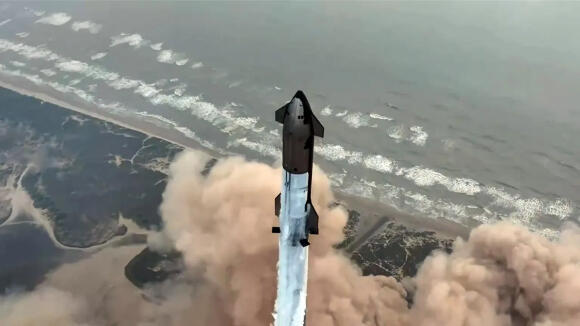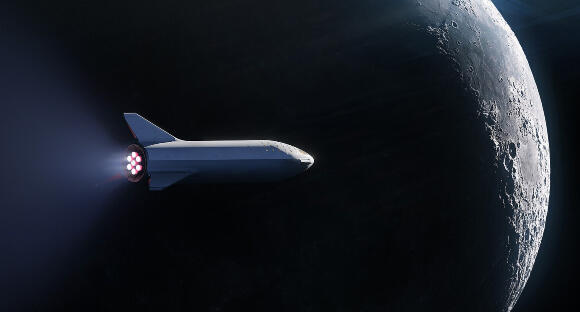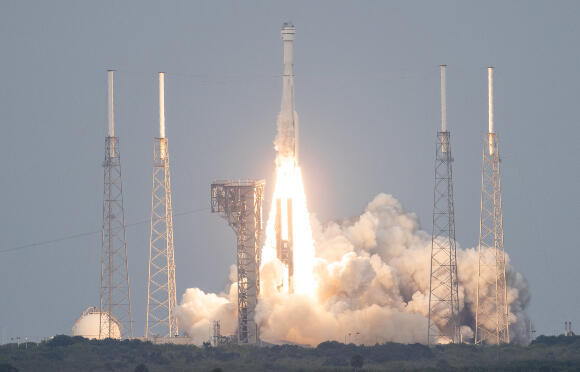SpaceX successfully completed the fourth test flight of its Starship spacecraft last Thursday, achieving all three main objectives of the mission: a successful return of the spacecraft to the atmosphere, and successful landing maneuvers of both the booster rocket and the spacecraft itself.
The Starship launched from the company's base in South Texas, and three minutes later, as planned, it detached from the booster rocket, the "Super Heavy." Unlike previous test flights, this time the rocket managed to stabilize itself after a free fall of over a hundred kilometers and positioned itself vertically above the Gulf of Mexico. In the future, the company plans to perform the landing maneuver at the launch site itself, where the hovering rocket will be caught by specialized arms located on the launch tower.
3 View gallery


Success in the three main objectives, gearing up for the major challenges ahead. Launch of the "Starship" for its fourth test flight
(Photo: SpaceX)
Meanwhile, the spacecraft continued its trajectory, re-entering the atmosphere over the Indian Ocean. Unlike previous tests that ended in fiery explosions shortly after re-entry, this time, despite losing many tiles from its heat shield and a portion of its wing, the Starship survived, executing a successful water landing maneuver. SpaceX CEO Elon Musk congratulated the company's employees on the successful test in a tweet.
SpaceX has made significant progress in each of the Starship test flights but still faces very big challenges in upcoming tests, as it prepares for future ambitious missions, primarily that of landing humans on the moon for NASA.
From the Dark Side to Earth
The Chinese Chang'e 6 mission has successfully collected soil samples from the far side of the moon. The spacecraft landed in the Apollo Basin last weekend, becoming only the second mission to land on the moon's far side, following the Chang'e 4 mission in 2019. Equipped with a scoop for collecting soil and rocks and a drill for extracting subsurface samples, the mission aimed to collect about two kilograms of lunar material. Part of the lander ascended from the lunar surface with the samples and successfully docked with the spacecraft waiting in lunar orbit. The spacecraft carrying the samples is expected to return to Earth in about three weeks, providing scientists with the first-ever samples from the moon's far side.
Researchers hope that the samples will help us better understand the geological differences between the moon's two sides, shedding light on its geological history and improving our understanding of its formation. The mission is also a step toward China's plan of landing humans on the moon and the eventually establishment of a manned outpost there.
3 View gallery


An illustration of the dearMoon mission depicting an early version of the Starship spacecraft igniting engines near the moon
(Photo: SpaceX)
The Moon Awaits Tourists
Japanese billionaire Yusaku Maezawa announced last weekend the cancellation of his moon tourism flight, which he was supposed to take with about ten artists aboard SpaceX's Starship spacecraft. The announcement came via a tweet on the official X account of the project, followed by Maezawa explaining on his own account that when he initially signed the contract with SpaceX CEO Elon Musk back in 2018, the assumption was that the mission would take place by the end of 2023. “It’s a developmental project so it is what it is, but it is still uncertain as to when Starship can launch. I can’t plan my future in this situation, and I feel terrible making the crew members wait longer, hence the difficult decision to cancel at this point in time, ” wrote Maezawa.
Musk and Maezawa unveiled the dearMoon mission in 2018, featuring a flight near the moon without landing or entering its orbit. The project's cost remained undisclosed, but estimates suggest the Japanese fashion tycoon invested hundreds of millions of dollars. He launched a global search to select ten artists from diverse backgrounds who would accompany him on the lunar journey, revealing the dearMoon mission crew composition at the end of 2022. The team comprises artists spanning photography, film, music, dance, and even an American snowboarder with a Winter Olympics gold medal.
However, Maezawa's interest in the project seems to have diminished, partly due to the loss of a significant portion of his wealth in recent years and partly because he didn't wait for Musk and proceeded with his own tourist flight to the International Space Station aboard a Russian Soyuz spacecraft. Meanwhile, SpaceX's priorities have also shifted, e particularly after NASA chose SpaceX's Starship in 2021 as the manned lunar landing vehicle for the Artemis program.
Consequently, the company expedited Starship's development, focusing on the capabilities required by NASA, such as in-space refueling. Despite NASA's funding, Starship's progress faced delays, with its first test flight only taking place in April 2023. Even with accelerated development, numerous tests lie ahead before it obtains certification for manned flight, a process likely to extend over several more years.
3 View gallery


Launch of the Starliner spacecraft from the Kennedy Space Center in Florida, June 5, 2024
( Photo: NASA/Joel Kowsky)
A Second Private Spacecraft – with Leaks
Boeing achieved a significant milestone with the successful launch of its inaugural manned spacecraft to the International Space Station. Dubbed the "Starliner," the spacecraft was launched from the Kennedy Space Center in Florida atop an Atlas V rocket from ULA, carrying two veteran NASA astronauts, Barry Wilmore and Sunita Williams, both embarking on their third spaceflight
The mission entails a series of extensive tests of the spacecraft, including manual flight in Earth's orbit and docking at the space station. Following several days at the station, the Starliner is scheduled to make a terrestrial landing in the southwestern United States, in contrast to the traditional sea splashdown of other American spacecraft. If all proceeds as planned, Boeing anticipates obtaining the necessary license to fly astronauts to the space station, thereby becoming the second company to do so after SpaceX, which has been conducting manned flights for four years.
Both Boeing and SpaceX were selected by NASA in a tender in 2014 to develop spacecraft for crewed missions to the space station. While five companies initially entered the competition eight years prior, only Boeing and SpaceX ultimately crossed the finish line. In the 2014 tender, Boeing secured a 4.2 billion contract compared to Spacex's 2.6 billion, which included the cost of conducting the first six manned flights. NASA had aimed to commence manned flights in 2017, but delays ensued, with SpaceX eventually launching NASA's inaugural astronauts aboard the Dragon spacecraft only in 2020.
Surprisingly, the aviation giant, initially considered a preferred candidate over the young company, lagged far behind. Only at the end of 2019 did it launch the first unmanned Starliner spacecraft, which failed to reach the space station due to a series of malfunctions. Another two and a half years passed until, in May 2022, the unmanned Starliner finally reached the space station. It successfully completed the test flight, but deficiencies discovered, including issues in the parachute system, delayed progress to a manned flight, causing the company enormous financial losses.
In recent months, the launch was repeatedly delayed due to faults in the launch vehicle and in the spacecraft itself. In the mission's early hours, it was found that, in addition to a helium leak from the spacecraft that had already delayed the launch, several more helium leaks were discovered in the system used to control and rotate the spacecraft around its axes. NASA and Boeing ground crews instructed the astronauts to shut down the leaking systems, asserting that the spacecraft remains stable and operational.
Boeing is now pinning its hopes on the successful completion of this mission to pave the way for manned flights to the space station and potentially other NASA-affiliated space missions. This achievement could help mitigate some of the project's financial losses and potentially rehabilitate Boeing's reputation, which has recently been marred by a string of malfunctions in its commercial aircraft.
The Veteran and the Cosmos
The veteran Hubble Space Telescope is poised to resume operations following a shutdown triggered by a malfunction in its gyroscope system. Approximately two weeks ago, NASA placed the telescope into "safe mode," halting its observations due to erroneous readings from the system responsible for stabilizing and directing it. In principle, the telescope uses three gyroscopes to monitor its position in the three axes of motion and direct its optical instruments.
However, it can function with only one gyroscope, which it will for now. Of the six gyroscopes installed during the last servicing mission in 2009, only two remain fully operational, with the third providing inaccurate readings. NASA has opted to operate the telescope with only a single gyroscope while retaining the last one as a backup.
According to NASA's pre-planned action plan for such a situation, the telescope's operating system will combine data from the single gyroscope with inputs from additional sensors such as cameras and magnetometers. However, this approach comes with a trade-off: the time required to position the telescope for each observation will increase, potentially leading to a significant reduction in its operational efficiency.
The 2009 servicing mission marked the fifth time astronauts visited the telescope, which orbits Earth at an altitude of over 500 kilometers. It was intended to be the telescope’s final mission, though recent discussions have floated the possibility of another repair mission, perhaps even involving private astronauts aboard a SpaceX mission. However, these plans remain speculative, and NASA hopes to keep the groundbreaking telescope operational for as long as possible, as it approaches over three decades of service.
Content distributed by the Davidson Institute of Science Education

